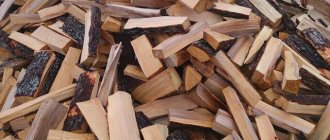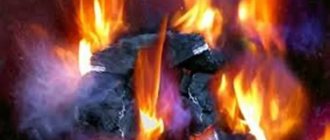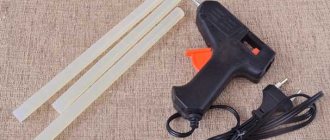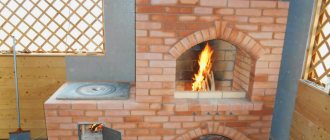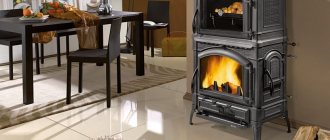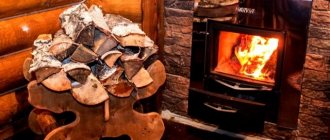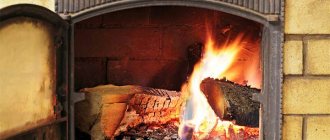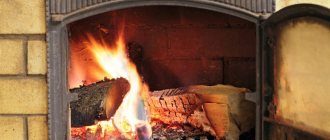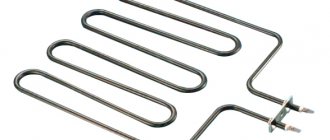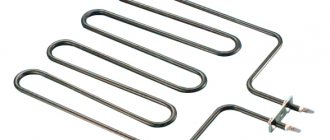Not long ago, an alternative fuel for lighting stoves appeared - fuel briquettes, which are positioned as an analogue of conventional firewood, but with better calorific characteristics. In order not to be unfounded, we decided to compare the capabilities of wood and European firewood, evaluate their technical characteristics, nuances of use and determine whether fuel briquettes or firewood are better for the consumer, which is more profitable.
Comparing firewood and fuel briquettes
Fuel briquettes or firewood – which is better?
It is advisable to start comparing different types of fuel with the cost of materials. If we analyze their price indicators, 1 m3 of Euro firewood will cost approximately twice as much as the same amount of ordinary logs. Moreover, the former are made from raw materials of varying value; the price of firewood is determined by the type of wood.
There are different products on the market. First-class briquette products have a denser structure, do not contain cracks or chips, and most often they are fired on the outside. Low-quality products are multi-layered, have lower density, and are vulnerable to mechanical damage. Such fuel burns faster and produces less heat.
The cost of fuel briquettes is approximately twice as much as regular firewood Source pankornik.pl
Advantages and disadvantages of artificial fuel
Eurofirewood got its name because of its regular geometric shape and is an alternative type of solid fuel (wood or coal). They are convenient for heating stoves, fireplaces, and using for solid fuel boilers and other types of heating appliances. In order to decide which type of fuel to give preference to, you should consider all the advantages and disadvantages of briquettes over firewood. To produce briquettes, waste from the food and wood processing industries is used. They include:
- sawdust;
- husks of cereals (rice, buckwheat) and industrial crops (sunflower);
- peat;
- straw.
The compressed briquette holds its shape due to the physical properties of the components included in its composition.
Ideal drying of the fuel material determines good combustion, compact and aesthetic appearance. No glue is used in the production of briquettes, so such products are environmentally friendly and safe for humans.
What to choose: coal or firewood?
Coal is perfect for heating boilers located in a separate room. It is not at all recommended to use it in a stove located in the home. This is due to the fact that such fuel burns for a long period and does not burn completely. For this reason, it is unacceptable to leave the chimney closed so that carbon monoxide does not accumulate in the room. At the same time, ordinary firewood always burns completely, releasing enough heat. This means that you can safely close the valve without fear for your health or heat leakage through the chimney.
Lighting charcoal without the right wood is a difficult task. Therefore, all those who use it are forced to purchase material for ignition.
Coal dust is considered quite harmful to human health. When throwing such fuel into the stove, you must try to prevent dust from rising into the air. Firewood contains almost no dirt, making it much safer.
As opposed to coal heating, traditional wood heating is more environmentally friendly: when burned, dry wood emits a small amount of carbon dioxide and therefore does not damage the natural environment. The latter is not typical for coal.
Unlike firewood, coal is not recommended for heating stoves located in residential premises Source tektarif.ru
What fuel should I use in my stove?
An important factor for maintaining a constant temperature is the correct choice of long-burning stoves, which are refueled periodically and the fuel in them burns much longer. Owners of country houses or summer cottages can use artificial firewood to heat their premises, but it is convenient to use briquettes to light a fireplace. To do this, it is better to place them on paper and birch bark, which will speed up the ignition process. In the same way, you can use firewood, which does not always light well. To prevent soot from remaining as sediment in the chimney, it is recommended to throw a pinch of table salt into the fire with each addition.
How to make briquettes with your own hands
If firewood or briquettes are not available, you can try to make the latter yourself. The main principle of Euro-firewood production is the compression of crushed wood waste until lignin begins to be released. This substance subsequently glues small particles into a monolithic product. For the production of fuel briquettes it is allowed to use: agricultural residues, sawdust, shavings, and other woodworking waste.
Procedure:
- Grind raw material.
- Dry to 10% moisture content.
- Using a hydraulic press or auger device, briquet the prepared raw materials.
The cheaper way to heat your home
The price of fuel for heating a private home is of great importance, but it is pointless to consider it in isolation from heat transfer. We will calculate the cost of heating taking into account both parameters.
Combustion of peat fuel 3 hours after laying
In the area where our expert lives, the following prices are asked for proven types of fuel:
- Freshly cut firewood – 20 USD. e. for 1 m³. Let's tie the price to the weight: 20 dollars for 600 kg or 33 cu. e. for 1 ton.
- Briquettes made from pressed sunflower husks – $57 per ton.
- Peat briquette – 84 USD. e./1 t.
It is easy to calculate that 10 kg of wood will cost 33 cents, the rest of the fuel - 57 and 84 cents, respectively. Then 1 hour of heating on wooden logs costs 33 / 1.5 = 22 cents (remember, the wood burned out in an hour and a half).
In a similar way, we determine the hourly rate for burning briquettes:
- pressed husk: 57 / 2.17 (2 hours 10 minutes) = 26 cents;
- briquetted peat: 84 / 3 = 28 cents.
Burning briquetted sunflower seed husks
Interesting result, right? In our case, heating up an absolutely cold building costs 5.28 USD. e. per day for wood, 6.24 dollars for pressed husks and 6.72 cu. e. - on peat “bricks”.
Please note that we took the cost of raw wood (and it will decay sooner) and divided it by the time of full combustion of dry wood. That is, the difference between traditional fuel and briquettes is minimized. We invite you to track the progress of the experiment on video and listen to an expert’s opinion on this matter.
Main varieties
There are three main types of Euro firewood offered on the modern market, which, while not having any fundamental differences in composition, differ from each other in the density of the internal structure and geometric shape:
- fuel briquettes RUF (RUF);
- European firewood Pini Kay (Pini Kay);
- fuel briquettes Nestro (Nestro).
Fuel briquettes Ruf
RUF wood briquettes, for the production of which sawdust, small chips or shavings are used, have the shape of a rectangle. They are distinguished by the lowest price when compared with other types of pellets. When using such fuel briquettes, it should be borne in mind that the heating boiler must be equipped with a forced ventilation system.
Fuel briquettes "Pini Kay"
Pini Kay fuel briquettes are fired at the final stage of production, which makes them more resistant to high humidity. Pellets of this type differ from RUF fuel briquettes in their geometric shape: in cross section they can have the shape of a cylinder or hexagon with a hole in the central part. Thanks to this hole, they can be successfully used even in ovens that are not equipped with a forced ventilation system. The cost of pellets of this type, which can be easily distinguished from RUF fuel briquettes even from a photo, is higher, which is explained by the more complex technology of their production.
Round fuel briquettes Nestro
Preparation of raw materials
As mentioned above, before the direct production of briquettes, the raw materials are crushed and dried. This process is not easy and takes place in several stages. To break down the largest waste, a 5P-RM type chipper is required. But the AC-3 aerodynamic dryer-shredder will help you finally prepare the waste for use.
You can use other similar devices, but these are the ones that in most cases provide the ideal result. Subsequently, the heat generator is switched on - and, finally, the worker gets the opportunity to form finished products.
Back to contents
Initial data for calculation
Calculation of solid fuel consumption per boiler during the season depends on many parameters: the area of the house and the height of the ceilings, the average temperature in the cold season, the duration of winter, the quality of the thermal insulation of the walls, the heat transfer of the fuel and the efficiency of the equipment.
It will not be possible to take into account all the variables, but we can calculate the average value for different types of fuel so that you can compare and choose the option that is right for you.
- Let's take the duration of the cold season as 111 days, from November 27 to March 13.
- The area of the room is 100 square meters.
- The amount of heat to heat 1 square meter is 100 W per hour.
- Accordingly, there are 24 hours in a day and an average of 30 days in a month.
If necessary, you can substitute into the formula the actual area of the house, the duration of the cold season, depending on the region of residence.
Advantages of firewood compared to briquettes
Calorific value of different briquettes
- There is no doubt that briquettes burn longer and emit stable heat, but they emit less heat than firewood. You won’t be able to quickly warm up a room using Euro-firewood; you’ll have to wait.
- If you want to spend a pleasant evening with a book, a cup of strong tea and a crackling fire in the fireplace, you will have to give up fuel briquettes. The fact is that Euro-firewood does not emit the crackling sound characteristic of ordinary firewood, which creates that unique feeling of home warmth. Firewood can provide this effect due to the water contained in it and absent in briquettes.
- No unpleasant odor from ashes. The ash remaining after the combustion of firewood does not have the tart odor characteristic of ash from European firewood.
- Briquettes of ordinary quality or RUF type can be quite fragile, sometimes even capable of crumbling right in your hands. However, there are high quality briquettes that are stronger.
Types of briquettes [ads-mob-1][ads-pc-1] So, these are the main differences between fuel briquettes and regular firewood. However, there is another important question that worries doubters: what is more profitable to buy?
Kinds
The method of processing raw materials plays an important role. Taking into account the manufacturing process, briquettes can be divided:
- Piny-kay. Fuel having the highest density of 1.40 g/cm3. The shape is similar to a cube or hexagon, which has a hole in the middle. The air inside the cavity ensures even combustion.
- Low density products – 0.8 g/cm3. These are squares or rectangles made from the smallest particles of material. They are characterized by high thermal conductivity and long-lasting combustion. Convenient to store and transport, do not take up much space.
- Products made from large sawdust with medium density. Their disadvantages include rapid combustion, frequent loss of shape and deformation. Due to low production costs, they have a relatively low price.
Pellets for solid fuel boilers
By analogy with briquettes, pellets are compressed granules from various woodworking and economic waste. The fuel is also environmentally friendly, has a homogeneous structure, but the calorific value is equal to that of coal. Pellets serve as fuel for pellet boilers, which are widely used throughout Europe.
Pellets for solid fuel boilers
The characteristics of pellets are similar to those of briquettes, however, they have such an indicator as humidity, which is no more than 10%. For comparison, freshly cut firewood has this figure within 50%. To maintain low humidity of pellets, they must be stored exclusively in a dry place, otherwise, as humidity increases, the calorific value of the pellets decreases. By the way, about storage: 1 ton of pellets occupies a space equal to 1 m (width), 1.1 m (length) and 1.6 m (height). It is preferable to store pellets in plastic bags.
As an example, we can give the characteristics of pellets made from sunflower husks:
You can buy pellets in Moscow for 5,500 rubles/t. both in big bags and in 25 kg bags. To find out in detail the cost of a product, you need to use price lists for pellets, where, in addition to the cost, the terms of delivery to consumers are indicated.
Technology
The most suitable raw material for the production of peat briquettes is low-lying peat, which does not contain any by-products and consists of fine particles. Fuel bricks from such low-lying peat are high-calorie and the most dense, dark brown, almost black in color. It is important to remember: fuel briquettes made from peat are used exclusively for boilers operating on solid fuel. The technology for producing peat fuel is quite simple and is as follows:
- peat chips are extracted by milling the upper layer of caustobiolite;
- using drying and turning, the crushed raw materials are brought to the required moisture content;
- Then the dried products are stored in piles.
The next production stage is drying the semi-finished product to 9-12 percent humidity. Then the raw materials are separated and sent to the press for briquetting. High pressure and temperature conditions of 200-350 degrees Celsius contribute to the melting of workpieces, increasing their strength.
The result is a peat briquette with certain parameters:
- briquette size – 150 x 70 x 60 mm;
- mass fraction of sulfur – within 0.2%;
- content of ash impurities – no more than 15%;
- standard humidity – within 18%;
- calorific value – from 4500 Kcal/kg.
This briquetted fuel is popular among private owners and is used in furnaces and boilers with controlled air supply. And the ash obtained from the combustion of peat briquettes, according to reviews from amateur gardeners, is an ideal mineral fertilizer with a high content of potassium and phosphorus.
You may be interested in an article on how to connect a gas boiler. You can read about the boiler room in a private house in this article.
In addition to the milling method of extracting peat raw materials, there is also a less expensive and simple method for harvesting sod peat. With the help of special attachments to the tractor, compaction takes place in areas where high-moor peat is being developed.
The completed briquettes are extruded directly onto the field and dried under natural conditions. This type of briquette is called “peat firewood”. The disadvantages of peat fields include low heat transfer and variability of consumer criteria. In most cases, boiler houses operating on solid fuel use peat firewood.
